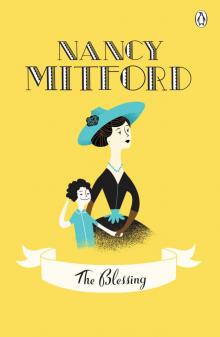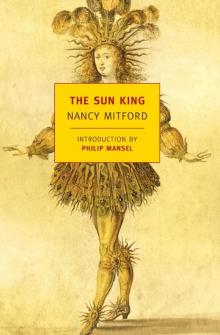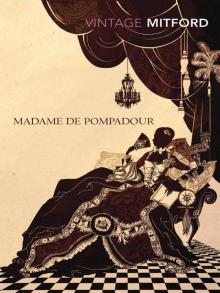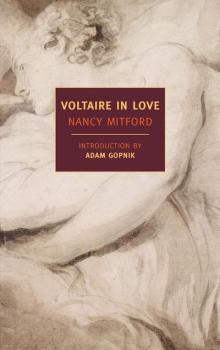- Home
- Nancy Mitford
Madame de Pompadour Page 4
Madame de Pompadour Read online
Page 4
Meanwhile every pretty woman in the lle de France nurtured a secret conviction that she would carry off the prize. Such was the prestige of a monarch in those days, so nearly was he considered as a god, that very little shame attached to the positon of his mistress, while the material advantages to her family were enormous. The monstrous fortunes of the Gramont, Mortemart, La Vallière and d’Estrées families were founded upon such relationships with various kings. The Queen having settled into a dreary little life with her unfashionable friends, gaiety and amusement centred on the King’s set and was led by his mistress. Besides all this, Louis XV was extremely attractive. He was tall and handsome, he had a most caressing look, a curious husky voice which nobody ever forgot who had once heard it, and a sexy moodiness of manner irresistible to women; the haughty air, which came in reality from shyness, in no way detracted from his charm. The wives of his subjects had no difficulty in falling in love with him, and Madame d’Etioles was not the only one who had done so. It was put about in Paris that he was tired of aristocratic mistresses, with their political ambitions and their grasping families; the bourgeoises were one and all agog.
But how to meet him? This was indeed a problem. True he often went, masked, to the public balls, both in Paris and in the town of Versailles. It was a pastime of which he was uncommonly fond, but the moment his identity was known, as it always was because of the way he carried his head and the unmistakable timbre of his voice, he would be mobbed; nobody could have a private word with him after that. A possible way would be an introduction through one of his body servants. These men, whose functions were handed down from father to son, whose families always ended by being ennobled, and who themselves employed between ten and twenty servants, were very important in the palace hierarchy. In some respects they had more influence with the King than any of his courtiers; he confided many things to them and was very fond of them. Madame d’Etioles had a distant cousin, one Binet, who was body servant to the Dauphin and who often, in the course of his duties, saw the King alone; no doubt she was in touch with him, but for the moment she did not make use of him.
At this juncture there were signs that the King would have liked to reform, and go back to the Queen. The Metz affair had not failed to make an impression on him; he was devoted to his daughters, growing up apace, and had no wish to offer a bad example to them, or to the Dauphin, who was nearly sixteen and just about to be married. Mesdames de Vintimille and Châteauroux had been extremely grasping, and had made themselves obnoxious to the Queen who, though most long-suffering as a rule, had once turned to Madame de Vintimille, when she asked for some favour, with ‘You are the mistress here, Madame.’ The King hated this sort of incident; it embarrassed him and he hated being embarrassed. But he also hated being bored, and if he had ever seriously considered a return to conjugal life, one look at the Queen’s existence must have made him realize that it would be more than he could bear.
Marie Leczinska was said by her intimates to be not only very good but also very amusing. They said that she had a noble mouth but a malicious eye, and hinted that, when her devotions were finished, she kept her friends in a perpetual roar of laughter. We must beg leave to doubt it. People lucky enough to belong to the circle of royal personages are fond of letting it be understood that they are less dull than they look; the friends of Marie Leczinska were no exception, but they cannot persuade us that she was anything but a dear old bore. Her jovial father, Stanislas, said that the dullest queens in Europe were his wife and daughter: ‘When I’m with her I yawn like at Mass.’ The amusing element at Court had always avoided her; now, in the midst of the liveliest society France has ever seen, she was living like a nun. Most of her day was spent in prayer, her only outings being to charitable entertainments or the convent where her unfashionable dresses were embroidered.
In the morning, between Mass and her state visit to the King, she read some moral tale, or did a little painting, for which her talent was pathetically meagre, as we can see by the example of her work which still remains at Versailles. She dined at 1 p.m., in public, eating enormously. After dinner she sewed for the poor until it was time for cards. Gambling was a great feature of the life at Versailles, enormous sums were won and lost, and everybody spent hours at the tables, even the young princesses. The Queen’s game was cavagnole, played with dice; it had long been out of fashion; comète and piquet were now all the rage. Nothing is so frumpish as last year’s gambling game and the courtiers complained terribly when they were made to play la triste cavagnole with the Queen. Two or three times a week her tables were put in the state rooms where the public was admitted, but nobody ever bothered to go and watch. After supper, her evening was given over to social life. Her ladies, who were chosen by the King, because they amused and attracted him, scampered off to his private rooms and she was left with her friends the Duc and Duchesse de Luynes.
The Duc de Luynes kept a journal in which almost every hour of life in the palace is accounted for. He is not a great writer like Saint-Simon, and three-quarters of his journal, devoted to questions of etiquette and usage, is almost unreadable; but he inspires confidence, he never writes anything of which he is not quite certain, and from time to time, in some anecdote or physical description, his pages come to life. Enormously rich, he and his wife were also close-fisted and dowdy, as is evident from the fact that they did not pull down Dampierre and build a modern château in its place, as almost anybody else would have. Beautiful Dampierre, a jewel of Louis XIII architecture, stands unchanged in its park, and still belongs to the Duc de Luynes. The Queen supped at least every other day with these friends; the Duke noting each year how many times. It was very expensive for them, and she once said to his brother that she really must make it up to them in some way; they waited, hopefully, but in the end only received gracious compliments.
The other guests at these suppers were always the same: Luynes’ son and daughter-in-law, the Duc and Duchesse de Chevreuse; his brother, the Cardinal de Luynes; Président Hénault, and Moncrif; all, except the Chevreuses, were over sixty. François de Moncrif, whose origins, certainly Scotch, are rather mysterious, was one of those hangers-on who, in all societies and in all ages, manage to create and maintain a position for themselves, for no very evident reason. He must have been extremely cosy. He was the ‘historian of cats’ and it was said that he got on in life by never scratching, having velvet paws, and never putting up his back, even when startled. The Queen thought he was so good as to be almost saintly; she little knew that in the passages of the Opéra hung a notice: ‘If one of the young ladies would care to sup with a nice little old man, she would find ninety-two steps to climb, quite a good supper and could earn ten louis.’ The nice little old man was Moncrif; the ninety-two steps led to his lodging in the Louvre, given to him by his friend the Queen. (A louis, in those days, was exactly a guinea. The Duc de Luynes says, ‘they give in London a guinea for a louis and in Lille a louis for a guinea.’ An écu was half a crown. The livre varied in value according to the monetary policy of the government. During the reign of Louis XV it was about twenty-four to the louis.)
The Duc de Chevreuse, who truly was all piety and goodness, was in love with the Queen and horribly jealous of Président Hénault; the King, the Dauphin and even the Queen herself used to make jokes about it. This little company sat sleepily round the fire, evening after evening; one or more of them would generally nod off, lulled by the snoring of Madame de Luynes’ old dog, Tintamarre. The Cardinal once woke up with a jump and called for an immediate meeting of the chapter.
Evenings such as these were not likely to attract the presence of Louis XV.
3
The Ball of the Clipped Yew Trees
IN FEBRUARY 1745, the Dauphin was married to the Infanta Marie-Thérèse-Raphaèle, sister of the King’s little rejected fiancée. He was the second of Louis XV’s children to marry. The eldest daughter was now wife of the King of Spain’s second son, the Infante Philip; she was always known as Madame Inf
ante.
A great round of festivities celebrated the Dauphin’s wedding. Though he and his sisters disliked balls, their father did not; he declared that at their age it was good for them to dance, and during the whole month of February they were given the opportunity of doing so nearly every night. There were balls in the apartments of Mesdames (the Princesses), in the town of Versailles, and in the palace riding school; the King danced continually and always with the same person. She was masked, but rumour had it that she was the lovely Madame d’Etioles. These fêtes culminated in a great ball at Versailles, and another at the Hôtel de Ville in Paris.
A few days before the palace ball was to take place, when nobody was talking of anything else, Président Hénault met Madame d’Etioles. He asked if she was going to it? Yes, she was. He said, with the fatherly solicitude of an old Lothario, that he hoped she had made suitable arrangements for accommodation; he had heard that every room in the whole town of Versailles was taken. She replied demurely that her cousin, the Sieur Binet, was kindly seeing to it for her.
The ball for the Dauphin’s marriage was perhaps the most splendid ever known in all the history of Versailles. The palace was illuminated inside and out, it glowed like a great bonfire at the end of the Avenue de Paris, which in its turn was a river of light, from the double line of coaches, all laden with guests, coming from the capital. Candles, torches, brands and flares cast a warm and variable radiance, very much more beautiful than electric headlights and flood lighting. The guests drove across the great courtyard, and got out of their carriages at the foot of the marble staircase in the south wing. Never had there been such a crowd at any previous ball, every pretty woman in Paris was there to try her chances with the King. When balls were given in the state apartments they were entirely open to the public; it sufficed to be properly dressed to be admitted. The men were obliged to carry swords, but even this regulation was arbitrary; everybody knew that the palace concierge did a brisk trade hiring out swords to would-be guests. At the top of the staircase one member of each party was required to unmask and give his name; otherwise there were no rules and no invitations were issued. On this occasion, the man who was supposed to take the names very soon gave up the unequal struggle; the crowd surged past him, through the Queen’s rooms, including her bedroom, into the Galerie des Glaces and on into the seven reception rooms known as the Appartement. These rooms each had a buffet and a band; it was hoped that too great a crush in the gallery would thus be relieved. But the guests, who behaved in a very free and easy way the whole night, shocking the courtiers with their lack of manners, merely paused to help themselves to food – fish, as Lent was in progress, fresh salmon, and soles, and pâté of trout – and then went back to the Galerie des Glaces, clutching plates and glasses. The prophecy of Nostradamus, that the floor would give way and only the King and the thirty people near him would be saved, was gallantly disregarded.
For a long time, royalties, including the King, were sought in vain; none had yet appeared. At last, one of the looking-glass doors was thrown open, and in came the Queen; she was unmasked, her dress was covered with bunches of pearls and the two famous diamonds, the Régent and the Sancy, sparkled on her head. She was followed by the Dauphin and his bride, dressed as a gardener and flower-seller, and the Duc and Duchesse de Chartres. All the other royalties present were masked; they included Prince Charles Edward of England, so soon to embark on his disappointing adventure. Time went on, and still no sign of the King. The Chartres vanished from the party; they were so fond of making love that they could hardly bear to take any time off; when they dined out they generally asked for the use of the hostess’s bed during the course of the meal; at Versailles they had their own to go to. The Princesse de Conti, mother of the Duchesse de Chartres and a grand-daughter of Louis XIV, removed her mask in the supper room imagining that somebody would spring up to give her a chair; nobody recognized her, nobody budged; she stumped away furiously muttering that she had never, in a long life, seen such impossible people.
The Dauphine danced with a Spanish grandee who knew all the gossip of Madrid and was clearly of great importance; he refused to reveal his identity although she begged him to do so. Presently the Marquis de Tessé, himself a grandee of Spain, had a long talk with him, found him absolutely delightful and invited him to dinner; the Spaniard never unmasked, and presently he vanished. Next day M. de Tessé’s Spanish cook confessed to him that the mysterious hidalgo had been none other than himself. This story went all round Versailles and was thought particularly enjoyable because of the Dauphine’s character. Like all the Spanish royal family she was extremely stiff, penetrated with the sense of her own importance. The French never liked her. She made it quite clear that she thought many of their customs too common for words, the use of rouge, for instance, and their passion for jokes. She was never seen to laugh at a joke, either with friends or at the play, and made it quite clear that she would not tolerate them from her ladies-in-waiting. The King put himself out for her to a touching extent, trying, in a hundred little ways, to make her feel at home; she was always most disagreeable to him, possibly from shyness but more likely, it was thought, because she disapproved of him. M. de Luynes, to whom anybody royal appeared in rather a rosy light, says that she would have been pretty had it not been for her red hair, white eyelashes, and an enormous nose which seemed to grow straight out of her forehead without any roots. She was, however, elegant and a beautiful dancer; the Dauphin, uxorious like all his family, had fallen in love with her at once.
At last, the door leading to the Œil-de-Bœuf, ante-chamber to the King’s apartment, was opened; everybody pressed forward. A very curious procession lurched blindly into the ballroom; eight yew trees, clipped like those in the garden outside, in the shape of pillars with vases on them. The King had made up his mind that, for once, he would be unrecognizable. In the print by Cochin of the scene in the great gallery, lit by eight thousand candles, many fancy dresses can clearly be made out and the yew trees are mingling with the crowd. Presently one of them went off with pretty Présidente Portail to a dark and solitary corner of the palace. She thought he was the King, and nestled happily among the twigs; but when she returned to the ballroom what was her fury to see that the real King, who had taken off his headdress, was engaged in a laughing conversation with Madame d’Etioles, dressed as Diana and also unmasked. ‘The handkerchief is thrown,’ said the courtiers. It was now clear to them that a love affair was beginning. Before they parted the King had arranged to meet her the following Sunday at the ball in Paris.
Next morning at eight o’clock the last carriage still had not left Versailles.
The Paris municipality now put its best foot forward. The Spanish marriage was popular; it was supposed to have eliminated the Pyrenees and turned them into a temple d’amour – such rubbish, said the courtiers – thus lessening the chances of war with Spain. The Dauphin was known to be in love and this was considered romantic; and then the King, the adored, the idol, was in such an interesting situation. The mood of the capital was one of benevolent jollity. The festivities on this Sunday evening must have been very much like those of a modern fourteenth of July, only far more elaborate, with free food and wine galore. As it was winter and therefore impossible to dance in the streets, seven ballrooms were built – at the Hôtel de Ville, which had its courtyard roofed in, at the Place Dauphine, two in the Place Louis le Grand (Vendôme), at the Place du Carrousel, in the rue de Sèvres and the Place de la Bastille. These ballrooms were designed with an attention to detail which has hardly been bestowed, since the eighteenth century, on something only intended to last one evening. They were like large summer-houses, Chinese in feeling, their walls were of pink marble and trellis work filled with vine leaves, bunches of grapes and flowers. Real palm trees, whose stems were garlanded with roses, and draperies of pink velvet fringed with gold, outlined the buffets which groaned with turkeys, boar’s heads and other delicacies. The chandeliers hung from garlands of flowers, and,
outside, the walls and roofs were covered with candles. Everywhere there were pictures and statues of the royal family; marble fountains flowed with wine. Except for the Hôtel de Ville, all these ballrooms were open to the public; the poorest of the poor came with their wives, their families and even their dogs to eat, and drink, and dance, and amuse themselves all night. There was also a subscription ball at the Opéra.
The Dauphin was to attend the masked ball at the Hôtel de Ville without his father, and there to thank the Parisians for their good wishes. It was expected that the King would look in later, in disguise. This ball was by invitation, but there had been considerable mismanagement, twice too many cards had been sent out and the crowd was so immense as to be almost dangerous. In spite of a second ballroom in the courtyard the guests could hardly move, it took hours to get up or down the stairs, and the women’s dresses were torn to pieces by the crush. The whole thing was a scandal, said the Parisians, who grumbled about it for weeks afterwards; the food had given out by three in the morning, and it was alleged that several people had died, of heat, or cold, or fatigue or asphyxiation.

 The Blessing
The Blessing The Sun King
The Sun King Wigs on the Green
Wigs on the Green Love in a Cold Climate
Love in a Cold Climate The Penguin Complete Novels of Nancy Mitford
The Penguin Complete Novels of Nancy Mitford The Pursuit of Love
The Pursuit of Love Frederick the Great
Frederick the Great Highland Fling
Highland Fling Madame de Pompadour
Madame de Pompadour Voltaire in Love
Voltaire in Love Don't Tell Alfred
Don't Tell Alfred Nancy Mitford
Nancy Mitford Christmas Pudding and Pigeon Pie
Christmas Pudding and Pigeon Pie